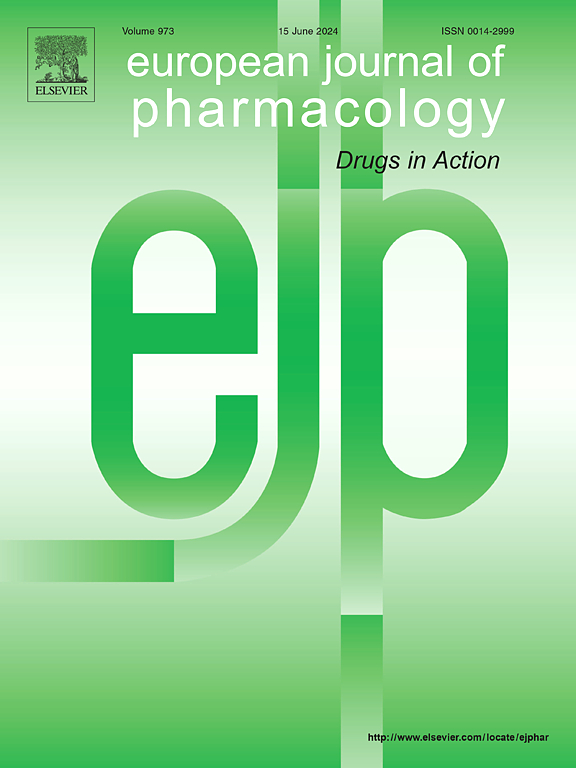Inhibition of lysophosphatidic acid receptor 2 attenuates neonatal chronic lung disease in mice by preserving vascular and alveolar development
IF 4.7
3区 医学
Q1 PHARMACOLOGY & PHARMACY
引用次数: 0
Abstract
Aim
Bronchopulmonary dysplasia (BPD) is a common morbidity in extremely premature infants. Previous studies demonstrated the important role of lysophosphatidic acid (LPA) in inflammation in BPD. However, the role of LPA and its receptors in hyperoxia-induced vascular malformations in BPD remains to be elucidated.
Methods and results
Elevated plasma LPA levels were observed in mice with BPD compared to controls (792 vs. 607 ng/mL, p < 0.05). Inhibition of LPA signaling protected against hyperoxia-induced lung injury in neonatal mice, demonstrated by a 2.8-fold increase in pulmonary vascular density and a 14% reduction in alveolar enlargement. In vitro studies showed that LPA suppressed tube formation in human umbilical vein endothelial cells (HUVECs) by approximately 50%. LPA receptor 2 (LPA2) was identified as a functional LPA receptor in primary endothelial cells from the lungs of hyperoxic mice and in HUVECs under hyperoxic conditions. The LPA2 antagonist H2L5186303 enhanced the tube formation ability of HUVECs exposed to LPA, both under normoxia (4-fold) and hyperoxia (5-fold). Moreover, H2L5186303 significantly protected against hyperoxia-induced vascular malformation (2-fold) and improved alveolarization in neonatal mice (12% decrease in mean linear intercept, MLI). Early growth response 1 (EGR1) was characterized as a downstream target of LPA2, silencing EGR1 restored tube formation in HUVECs exposed to LPA and hyperoxia.
Conclusions
Our in vitro and in vivo findings demonstrate that the inhibition of LPA/LPA2 signaling mitigates hyperoxia-induced pulmonary vascular malformations, suggesting the LPA/LPA2-dependent signaling pathway has therapeutic potential for extremely premature infants with BPD.
抑制溶血磷脂酸受体2可保护血管和肺泡发育,从而减轻小鼠新生儿慢性肺病。
目的:支气管肺发育不良(BPD)是极早产儿的常见病。以往的研究表明,溶血磷脂酸(LPA)在 BPD 的炎症中起着重要作用。然而,LPA及其受体在高氧诱导的BPD血管畸形中的作用仍有待阐明:与对照组相比,BPD 小鼠血浆中的 LPA 水平升高(792 vs. 607 ng/mL,p < 0.05)。抑制 LPA 信号传导可保护新生小鼠免受高氧诱导的肺损伤,肺血管密度增加了 2.8 倍,肺泡增大减少了 14%。体外研究表明,LPA 可抑制人脐静脉内皮细胞(HUVECs)中管的形成约 50%。在高氧小鼠肺部的原代内皮细胞和高氧条件下的 HUVECs 中,LPA 受体 2(LPA2)被确定为一种功能性 LPA 受体。LPA2 拮抗剂 H2L5186303 能增强暴露于 LPA 的 HUVECs 在常氧(4 倍)和高氧(5 倍)条件下的管形成能力。此外,H2L5186303 还能显著防止高氧引起的血管畸形(2 倍),并改善新生小鼠的肺泡化(平均线截距减少 12%)。早期生长反应 1(EGR1)是 LPA2 的下游靶标,沉默 EGR1 可恢复暴露于 LPA 和高氧条件下的 HUVECs 的血管形成:我们的体外和体内研究结果表明,抑制 LPA/LPA2 信号传导可减轻高氧诱导的肺血管畸形,这表明 LPA/LPA2 依赖性信号传导途径对患有 BPD 的极早产儿具有治疗潜力。
本文章由计算机程序翻译,如有差异,请以英文原文为准。
求助全文
约1分钟内获得全文
求助全文
来源期刊
CiteScore
9.00
自引率
0.00%
发文量
572
审稿时长
34 days
期刊介绍:
The European Journal of Pharmacology publishes research papers covering all aspects of experimental pharmacology with focus on the mechanism of action of structurally identified compounds affecting biological systems.
The scope includes:
Behavioural pharmacology
Neuropharmacology and analgesia
Cardiovascular pharmacology
Pulmonary, gastrointestinal and urogenital pharmacology
Endocrine pharmacology
Immunopharmacology and inflammation
Molecular and cellular pharmacology
Regenerative pharmacology
Biologicals and biotherapeutics
Translational pharmacology
Nutriceutical pharmacology.

 求助内容:
求助内容: 应助结果提醒方式:
应助结果提醒方式:


